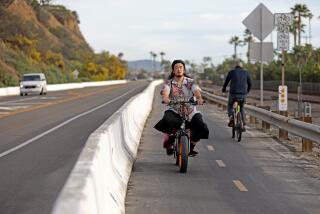Bikers, Walkers Driven to Unseat Motorists
- Share via
The parking lot at the Ventura fairgrounds was virtually empty Thursday for the start of California’s major conference to promote bicycling and walking. But that’s exactly what event organizers expected.
Scores of participants hiked, pedaled and skateboarded to Walk and Roll California 2005, a two-day strategy session aimed at getting people out of their cars and on their feet or bicycle seats.
“We practice what we preach,” said conference organizer Gail Payne, a Berkeley-based transportation planner who specializes in cycling and pedestrian issues. “Our mission is to make sure bicycling and walking are safer and more accessible throughout California.”
In a land where the car is king, that is no easy task. But conference organizers say their efforts have been aided lately by skyrocketing gas prices and an emerging battle against obesity, issues that have made cycling and walking more attractive to the public.
Still, those gathered Thursday at the oceanfront fairgrounds say they have plenty of speed bumps to maneuver.
Specifically, event organizers pointed to an ongoing campaign to persuade Gov. Arnold Schwarzenegger to sign a bill that would maintain the current funding level in the state’s bicycle transportation account. The account, funded at $7.2 million annually, pays for bicycle-related road and facility improvements.
The bill, SB 523, sponsored by Sen. Tom Torlakson (D-Antioch), was passed by the Assembly and Senate and landed on the governor’s desk Tuesday. A spokesman said Thursday that the governor had not taken a position on the legislation.
Sacramento lobbyist Justin Fanslau, who worked for months on behalf of the California Bicycle Coalition to get the bill through the Legislature, urged conference participants to speak out.
“We need all of you here to sign this petition,” said Fanslau, standing next to a 7-foot-tall placard destined for the governor’s office. “We need to send a message that this is very important.”
This is the second statewide conference sponsored by the California Bicycle Coalition. The first was in Oakland in 2003.
This year’s agenda includes sessions on mapping bicycle and pedestrian routes, creating innovative bikeway designs and encouraging students to get to school on two wheels instead of four. There are also plenty of activities built in for participants, including bike rides along Ventura’s river trail, which is studded with public artwork.
Participants said this year’s conference, which ends today, comes at a good time. President Bush last month signed a massive transportation bill, with about $23 billion going to road projects in California. About $90 million of that money is earmarked for projects that don’t involve motorized vehicles, providing a golden opportunity to pitch ideas to boost bicycling and walking.
Ideas that sprang from the 2003 conference have been replicated nationwide, including creation of the Safe Routes to School program, which encourages communities to find ways to help students walk and bike to school. The federal transportation bill will help fund that initiative in all 50 states, said Deb Hubsmith, coordinator for the national program and advocacy director for the Marin County Bicycle Coalition.
“This conference has served as an incubator for innovative ideas that have spread throughout the U.S.,” said Hubsmith, who totaled her car in 1996 and has since used a bicycle as her primary means of transportation. “We want to make bicycling and walking an integral part of American life once again.”
Although plenty of innovative ideas were being floated Thursday, Ventura bicyclist Ruth Owens reminded a room full of transportation planners and engineers that at the core, it’s still about the basics.
Headlining a session titled “The Good, Bad and Ugly: Pros and Cons of Bike Routes in Ventura From a Rider’s Perspective,” Owens chronicled the challenges of her 19-mile round-trip bike commute from her home in Ventura to her job as an environmental engineer at the Naval Base Ventura County.
Using a series of slides, she highlighted dangerous intersections, crumbling and narrow sidewalks, and bicycle lanes that end without warning.
“Anything you guys can do to keep us away from cars would be appreciated,” said Owens, an avid cyclist and member of the Channel Islands Bike Club. “You really want to keep bikers’ safety in mind.
“If we get good routes, we are going to be more likely to use them.”
More to Read
Sign up for Essential California
The most important California stories and recommendations in your inbox every morning.
You may occasionally receive promotional content from the Los Angeles Times.










